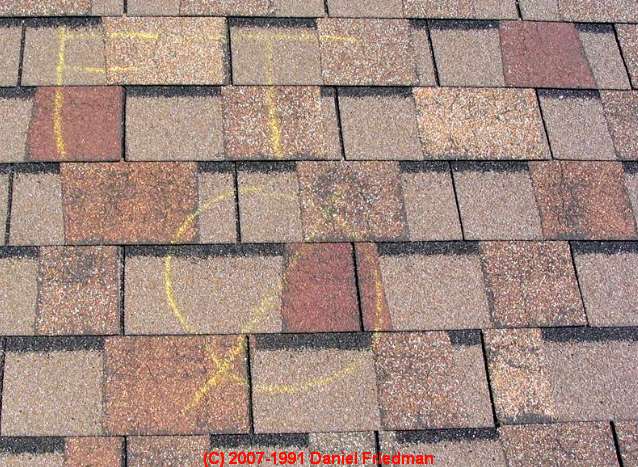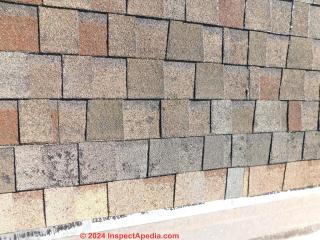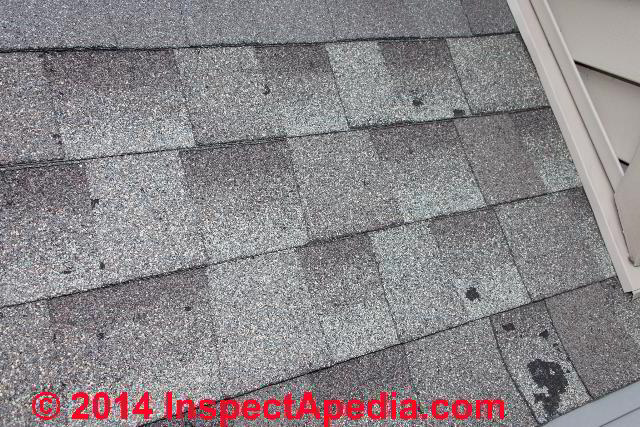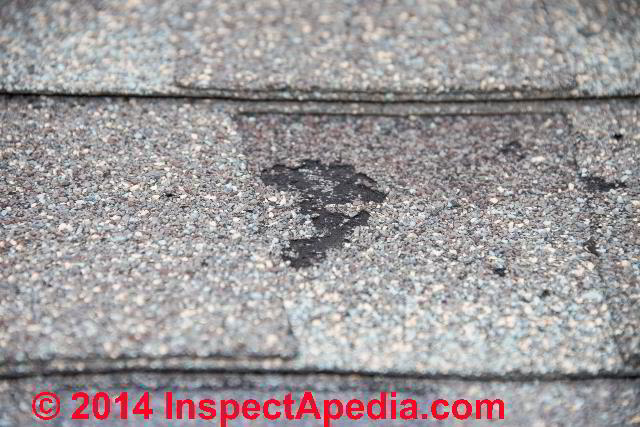 Marking Codes for Asphalt Roof Shingle Hail Damage
Marking Codes for Asphalt Roof Shingle Hail Damage
Suggested chalk codes used to indicate location, type & extent of hail damage on a roof
- POST a QUESTION or COMMENT about roof shingle hail damage & how hail damage is distinguished from blistering, foot traffic, or other roof wear, & about roof inspection procedures
Hail damage marking codes for asphalt roofing shingles are explained here.
We provide a set of chalk codes that can be used in marking areas of wear or damage on roofs to assist in photo documentation of roof condition.
In turn, that roof inspection and marking of areas of damage assists in roof shingle damage claim processing by your insurance company.
InspectAPedia tolerates no conflicts of interest. We have no relationship with advertisers, products, or services discussed at this website.
- Daniel Friedman, Publisher/Editor/Author - See WHO ARE WE?
Convention for roof damage chalk marking codes
In our roof damage photo shown at left, the chalk marks made on the roof by a local inspector were intended to aid in photo-documentation of roof conditions at the time of the inspection, and the inspector opinion about the cause of wear or damage.
To permit close examination and to support those conclusions, sharp closeup macro photographs of the roof surface can often make quite clear the type of roof wear or damage at that site.
Article Contents
- BASIC CHALK MARKING CODES
- TABLE OF COMMON CHALK MARK CODES WITH SLOPE IDENTIFICATION
- OTHER CONDITIONS TO RECORD: RULERS & SCALE INDICATORS
Basic Chalk Marking Codes
- Circle Slash roof damage marking code:
the inspector used the circle/slash to show an area of the roof where there was NO damage or loss due to "hail hits" or hail damage - this was a hail damage case.
His mark is more or less in the center of interest, and interestingly, in this inspector's case his circle/slash appear to have been made over an area where there was not obvious granule loss, perhaps for comparison with the shingles nearby that did show granule loss. - "FT" roof damage marking code:
by convention some roof inspectors use FT to indicate granule loss or other roof surface damage due to foot traffic or walking-on traffic. - "HD" roof damage marking code:
can be used to mark example areas of roof damage due to hail or ice striking the roof surface
A roof inspector might also use that mark to indicate where they were going to recommend removing a shingle for testing or submission to a manufacturer.
It's SOP for inspectors to use chalk marks to indicate specific observations on a roof that are also to be photographed. Inspectors use chalk usually to mark or indicate the following
- F or R or N,S,E,W
are used to indicate the particular roof slope on which the photograph was taken - Circles, lines, or arrows
to indicate roof areas of hail damage or hail hits or mineral granule loss due to scouring or other specific damage to be identified in the roof inspector's report - SPLT + arrows
mark roof areas where there are shingle splits that may be hard to see without up-close access - R/R or R&R or CUT
mark a roof area where a shingle is to be removed (and patched) for independent lab testing
Some insurance claims investigators include in their chalk marks both the type of damage and an indicator of which roof slope was involved: a great idea since the orientation of the roof slope may not be evident in roof damage photos and also because differences in damage found on different roof slopes can be diagnostic in assigning a damage cause.
Table Of Common Chalk Mark Codes
Table of Common Roof Damage Chalk Mark Codes Including Slope Identification |
||
| Roof Slope | Damage Type | Marking Code - Slope - Damage Type |
| North Slope | Foot traffic | NFT |
| Granule Loss | NGL | |
| Hail | NH | |
| Hail (alternative) | NHD | |
| Nail Pop | NNP | |
| No Damage Visible (reference area for comparison) | NNDF (no damage found) or use circle/slash symbol | |
| Pock Mark | NP | |
| Area to be cut for further testing | R/R or R&R or CUT | |
| Splits (thermal splitting) | NSPLT | |
| Wear/Tear (normal aging) | NW/T | |
South Slope East Slope West Slope or Front Slope / Rear Slope, Etc. |
Use same damage types | Change roof damage marking code first letter to correspond to the roof slope facing direction: S = South Slope Example: Hail damage code = SH E = East Slope Example: Nail pop code = ENP W = West Slope Example: Granule loss code = WGL Use F, R, for front or rear slopes if you prefer. However since the rough compass-facing direction of roof slopes can assist in relating damage to known direction of winds, rain or hail storms, the compass directions used above are more helpful. |
Notes to the table above
Thanks to Paul Stumpff, AIC, AIS, AINS, an Iowa insurance claims representative who contributed the Hail, nail pop, pock mark, wear/tear, granule-loss roof damage marking codes by email 2015/23/11
I am not aware of a national standard on roof inspection markings that specifies particular codes or symbols, but we'll continue to research this topic. CONTACT us to report other roof shingle chalk marking schemes used during roof inspections.
Other roof condition details to be recorded during a roof inspection: rulers & scale indicators
Incidentally, in my own roof inspections I will often place a ruler or other indication of scale in some photographs, and unlike the page top photo repeated just above, I also make closeup macro-photographs that indicate clearly instances of pitting, thermal splitting, mechanical damage etc.
I also photograph the entire field of the roof and I prepare comparative photographs of both damaged and undamaged roof areas and photographs that allow comparison of the condition of roof slopes facing different directions, at different pitches etc.
And a roof inspection is incomplete without a site and building inspection that identify other conditions that might effect the roof. Even a wet or flooding basement or crawl area can have a significant impact on the condition of a building roof, as that moisture moves up through the building and into the attic or roof cavity.
Those details help remove ambiguity or avoid arguments about just what was found in an up-close inspection of roof surface conditions.
Size of Roof Test Square When Reporting Hail Damage
Some inspectors suggest marking off a 10' x 10' test square area and counting the number of hits or marks ascribed to hail damage as a step in assessing the extent of hail damage to a roof. This approach has some sense to it in that it attempts to get past arm-waving speculation about the extent of damage to a roof.
But the roof damage test square approach can have some shortcomings too, depending on how it is applied. Just counting marks indicating hailstone strikes does not adequately consider the depth of damage or the degree to which the roof shingle substrate has been exposed.
And choosing an area for a test square is vulnerable to subjectivity or deliberate skewing of the report results.
For example, choosing as a test square a roof slope that was by its orientation less damaged or not damaged at all compared with other roof slopes on the same building will give an inaccurate assessment of the building's roof system.
...
Reader Comments, Questions & Answers About The Article Above
Below you will find questions and answers previously posted on this page at its page bottom reader comment box.
Reader Q&A - also see RECOMMENDED ARTICLES & FAQs
On 2020-12-09 by Nate - is there a wind damage marking code?
Working a hurricane. Is there a proper way to slash for wind damage?
On 2020-12-09 by danjoefriedman (mod)
Nate
Thanks that's a helpful roof damage code question.
I collect and report above the hail and wind and storm damage codes used by inspectors for a number of insurance companies, but I have not found a national nor international standard for these codes.
Let's add what you've been using - if you have a photo or two (one per comment) that'd be helpful and might prompt comment from other readers.
On 2020-08-05 by Kenneth Hall - details on how hail damages shingles
 I have numerous photos of damage exactly like this a day or 2 after the storm. Before and after pics a month apart and pictures of the hail. that created the damage still on the ground 30 hrs after the storm.
I have numerous photos of damage exactly like this a day or 2 after the storm. Before and after pics a month apart and pictures of the hail. that created the damage still on the ground 30 hrs after the storm.
2"+ clusters of smaller stones stuck together. and 2" hail with a clear solid crust over a large white air filled soft core.
in another case. these types of hail deflect the mat popping the coating off during thermal shock from the sudden temperature drop. taking the granules off with it where the coating separated from the mat.
In most cases the coating and granules were in tact in portions of the impact area just like a typical hail impact.
Hail that breaks up easily while very large looses it energy as it shatters just like the front of your car is designed to absorb the impact energy by collapsing to reduce the damage to the surface it contacts and the occupants inside.
This kind of hail even over 2" does not fracture the mat but separates the coating form the mat as the cold asphalt fractures from the deflection. Try hitting steep asphalt with a hammer when it is cold and what happens.
OR look at exposed asphalt flood coats on BUR roofs and what do you see? Asphalt coating shatters and chips when impacted by hail. This happens fairly often on asphalt shingles struck by large softer hail or clusters of smaller hail stones stuck together. Technical Expert Premier Claims.
On 2020-08-08 by danjoefriedman (mod)
Kenneth
It would be valuable to see your "before" photos of the same roof area.
Thank you for the helpful comments.
Reader Question: Roof inspection procedures: decoding common chalk marks used by roof inspectors to indicate areas of damage or wear
 The photo at page top [and shown again at left] in this web article on roof damage inspections
The photo at page top [and shown again at left] in this web article on roof damage inspections
shows a circle with
a line drawn thru
and FT
which I figure is meant to indicate "front".
What does the circle with the line indicate?
Appreciate your help. - R.B.
Reply: Convention for roof damage chalk marking codes
The chalk marks were made on the roof by a local inspector.
In our roof damage photo shown at left and above the circle/slash was an area where the roof inspector opined there was no damage,
and the "FT" marked above that spot was being used to indicate granule loss due to foot traffic.
Details about chalk codes used to mark on roofs during inspections and to indicate observations are in the a
Reader Question: Insurance company says shingle defect, GAF says hail damage
We've been told by [our insurance company] that this is the result of manufacturer defect. We filed a warranty claim with GAF and they claim their lab results indicate that the shingles are still up the MFG spec and this is hail damage.
They will not cover this under warranty. I've been told by 3 separate people (contractors and adjuster) that they've never seen shingles this bad before and that this is a serious defect.
[Click to enlarge any image]
April 12th we had a significant hail storm come through and many in the immediate area (next door neighbors) received full roof replacements and none of them looked like this.
These are over a majority of the roof. Are you able to provide any advice or information on what this is and who we could contact to verify GAF's claims? GAF will not supply copies of their lab analysis.
It was brought to my attention by an adjuster that even if this was a defect the hail damage is a subsequent loss and should still be covered under the ensuing loss clause in our policy. - J.F. 8/12/14
Reply: inconclusive photographs of roof shingle granule loss: sorting out hail damage from shingle defect, possible role of shingle blistering
I looked at your photos with interest, though there was not enough information for me to have a confident opinion.
I saw what looked like fragile edges to the bald areas where granules were lost that could indeed suggest recent hail damage and granule loss.
But I also saw weathering [whitening, loss of asphalt] of the exposed shingle substrate black asphalt-filled surface that would have suggested old granule loss. Then I re-read in your note that the hail storm occurred last April.
If your photos of April believed-hail-damage were taken in August, about 4 months later, possibly the whitish weathering I saw occurred on the exposed shingle substrate during that interval.
What I could not see in the shingle photos was good evidence supporting a shingle defect assertion by the insurance company but that doesn't mean they're wrong.
For example, if there was surface blistering on the shingles from time of installation, a fabrication artifact that the manufacturers assert is of only cosmetic import, then those shingles would indeed be more vulnerable to impact damage from hail - which breaks the blister tops and leaves substrate exposed.
Unfortunately even if that were the explanation for this case, we're left in a finger-pointing contest.
The granule loss will be blamed on hail by the manufacturer who has an arguable position, while the granule loss brought on by hail but really occurring in the exact locations where it did because there was blistering will be mustered as a shingle defect argument by the insurer.
When you said there were lab tests - were shingle samples sent to the manufacturer for testing?
And if so, did you point out to GAF that if they refuse to provide test lab results that makes their report to you not only less credible, but puts you in an impossible position with your insurance company?
You'd think that if an independent shingle test lab report supports a particular argument made by GAF then they'd be willing to provide the supporting data.
About ensuing loss - that's the value of hiring an expert, independent adjuster who understands insurance policy language - ultimately that may be your best bet.
Also missing from the discussion is a more clear interpretation of the present condition of the shingles and (for you and your adjuster) what that means as a possible basis for insurance claim.
More specifically, roof shingles with bald areas where no protective mineral granules remain are going to wear at an accelerated rate, speeding the time when either leaks occur (risking costly building damage or mold contamination) or when roof replacement is needed to prevent such leaks.
Meaning of "Shingles are Within Specification"
I would like some clarification from GAF on what was meant by shingles being "within specification" since in my opinion, no asphalt roof shingles with notable bald areas can be considered having a long remaining service life.
- Thus if the granule loss occurred due to hail there is a loss (of roof value and remaining life) following the hail storm.
- If the granule loss occurred due to a product defect (or a combination of product defect and subsequent hail) there is still a loss of remaining roof life that could raise a roof warranty claim question.
In sum, sorry but from just your photos I am not confident about a conclusion. I'd need to see more, better images, test reports, or to have on-roof access.
...
Continue reading at SHINGLE HAIL DAMAGE RESISTANT PRODUCTS or select a topic from the closely-related articles below, or see the complete ARTICLE INDEX.
Or see these
Recommended Articles
- HAIL DAMAGED SHINGLES & OTHER ROOF COVERINGS - home
- SHINGLE HAIL DAMAGE vs SHINGLE BLISTER RASH
- SHINGLE HAIL DAMAGE REPLICATION
- SHINGLE HAIL DAMAGE CHALK MARKING CODES
- SHINGLE HAIL DAMAGE RESISTANT PRODUCTS
- WARRANTIES for ROOF SHINGLES
Suggested citation for this web page
SHINGLE HAIL DAMAGE CHALK MARKING CODES at InspectApedia.com - online encyclopedia of building & environmental inspection, testing, diagnosis, repair, & problem prevention advice.
Or see this
INDEX to RELATED ARTICLES: ARTICLE INDEX to BUILDING ROOFING
Or use the SEARCH BOX found below to Ask a Question or Search InspectApedia
Ask a Question or Search InspectApedia
Try the search box just below, or if you prefer, post a question or comment in the Comments box below and we will respond promptly.
Search the InspectApedia website
Note: appearance of your Comment below may be delayed: if your comment contains an image, photograph, web link, or text that looks to the software as if it might be a web link, your posting will appear after it has been approved by a moderator. Apologies for the delay.
Only one image can be added per comment but you can post as many comments, and therefore images, as you like.
You will not receive a notification when a response to your question has been posted.
Please bookmark this page to make it easy for you to check back for our response.
IF above you see "Comment Form is loading comments..." then COMMENT BOX - countable.ca / bawkbox.com IS NOT WORKING.
In any case you are welcome to send an email directly to us at InspectApedia.com at editor@inspectApedia.com
We'll reply to you directly. Please help us help you by noting, in your email, the URL of the InspectApedia page where you wanted to comment.
Citations & References
In addition to any citations in the article above, a full list is available on request.
- In addition to citations & references found in this article, see the research citations given at the end of the related articles found at our suggested
CONTINUE READING or RECOMMENDED ARTICLES.
- Carson, Dunlop & Associates Ltd., 120 Carlton Street Suite 407, Toronto ON M5A 4K2. Tel: (416) 964-9415 1-800-268-7070 Email: info@carsondunlop.com. Alan Carson is a past president of ASHI, the American Society of Home Inspectors.
Thanks to Alan Carson and Bob Dunlop, for permission for InspectAPedia to use text excerpts from The HOME REFERENCE BOOK - the Encyclopedia of Homes and to use illustrations from The ILLUSTRATED HOME .
Carson Dunlop Associates provides extensive home inspection education and report writing material. In gratitude we provide links to tsome Carson Dunlop Associates products and services.




